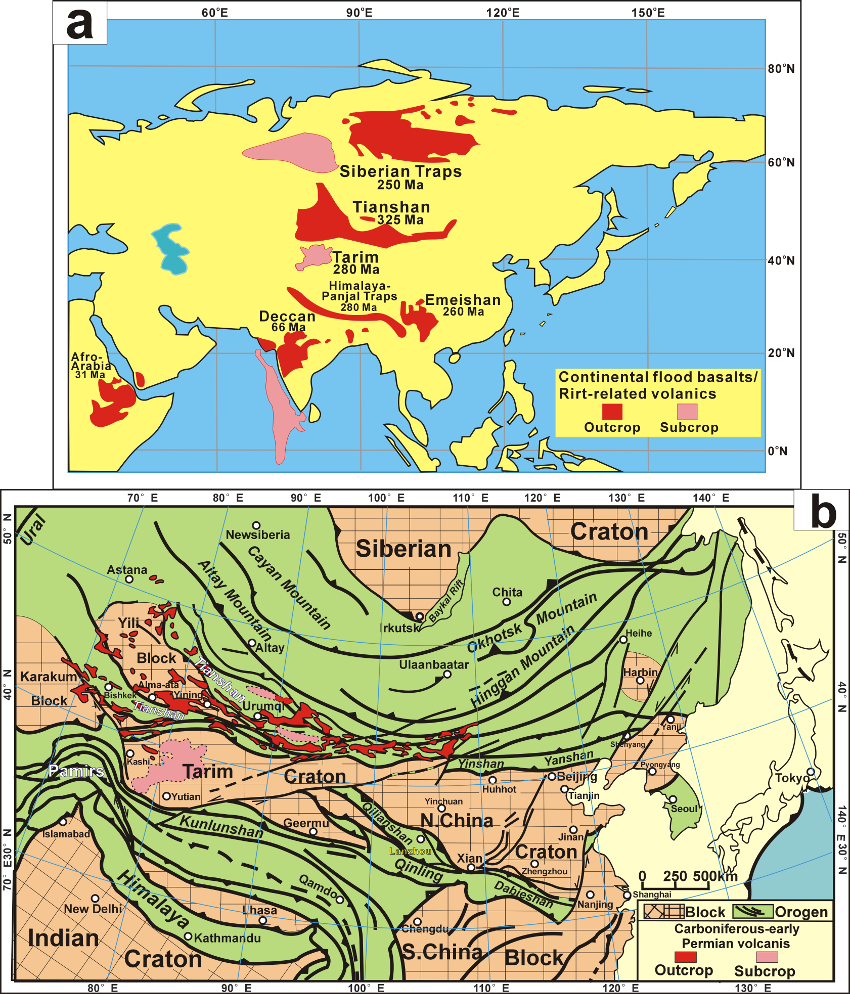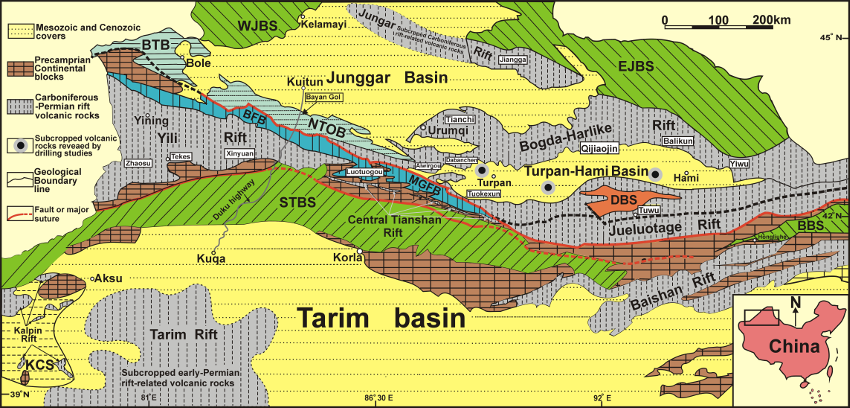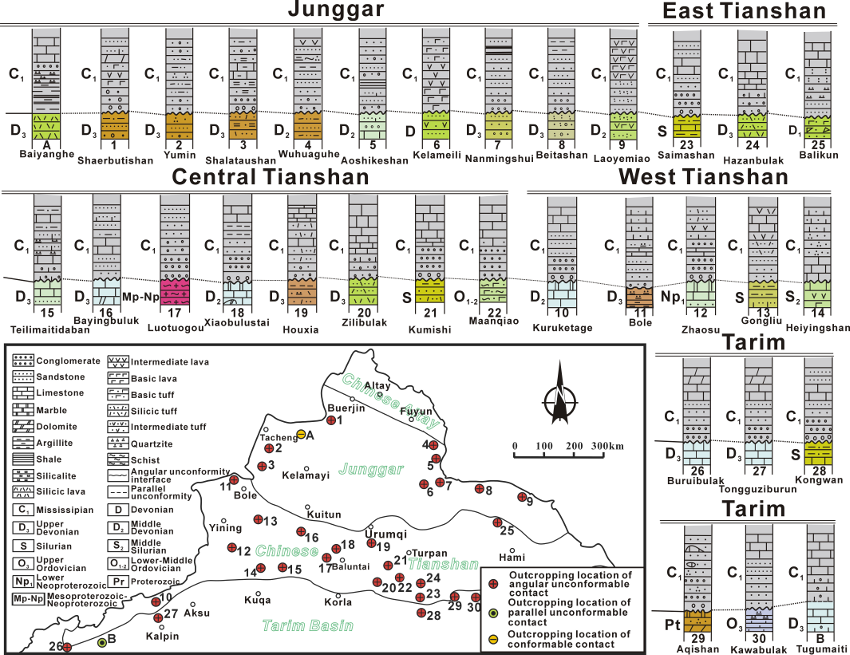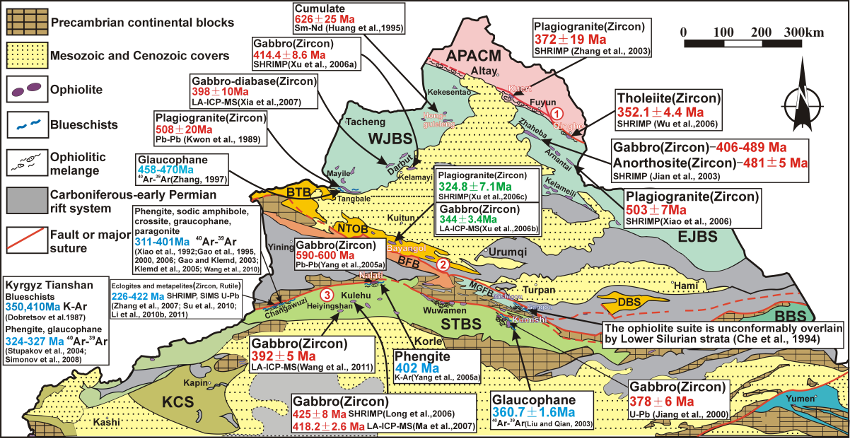June 2014 LIP of the Month
The Carboniferous–Early Permian Tianshan–Tarim LIP of northwestern China
Linqi Xia (xlinqi@cgs.cn)
Xueyi Xu
Xiangmin Li
Zhongping Ma
Zuchun Xia
Xi’an Institute of Geology and Mineral Resources, China Geological Survey, Xi’an, Shaanxi 710054, China
Editor’s comment: Several previous LIP of the Month contributions addressed the Tarim LIP: its basaltic magmatism (June 2006 , and July 2009), on silicic magmatism (December 2011), and associated metallogeny (October 2013). The Tianshan LIP was introduced in November 2005. The present contribution considers both the Tianshan and Tarim magmatism to belong to a single LIP and to arise from the same mantle plume.
The Carboniferous-Early Permian rift-related volcanic successions, covering large areas (~1.7×106 km2) in the Chinese Tianshan and its adjacent areas, make up an important Phanerozoic Large Igneous Province (LIP) (Xia et al., 2004, 2008a,b, 2012), which can be further divided into two sub-provinces: Tianshan and Tarim (Fig. 1) (Bryan and Ernst, 2008; Xia et al., 2012). Many mafic–ultramafic layered intrusions and widespread granitic magmatism also developed in these areas during this period. The available isotopic dating data reveal that the Carboniferous–Early Permian volcanism persisted for c. 90 Myr (from 350 to 260 Ma), but the Tianshan–Tarim LIP event exhibits two pulses of high volume activity; a first major pulse occurred at 335–325 Ma and a second major pulse at 285–275 Ma. The Carboniferous volcanic successions are mainly exposed in the Tianshan and Junggar areas, and a small portion is buried beneath the Junggar basin (Fig. 2). The Early Permian volcanic successions are mainly developed in the Kalpin, the Tarim (subcrop) and the Baishan rifts, and they are also sporadically exposed in the Tianshan area (Fig.2). There have been two different opinions concerning the geological setting of the Tianshan Carboniferous volcanic rocks. Some have considered them to represent island arcs or continental arcs (e.g., Zhu et al., 2005, 2009; Wang et al., 2007a,b; Tang et al., 2010) and others have proposed them to be developed in a continental rift (Xia et al., 2012, and references therein). The Permian volcanic rocks have been considered to be the products of intraplate volcanism by most researchers (e.g., Chen et al., 2006; Xia et al., 2004, 2008b, 2012; Zhou et al., 2009; Yang et al., 2005, 2007; Zhang et al., 2010; Tang et al., 2010).
Various factors are consistent with final closure of the Paleo–Asian Ocean already by the Early Mississippian: the regional unconformity of Lower Carboniferous upon a basement of pre-Carboniferous rocks (Fig. 3), the ages (360–351 Ma) of the youngest ophiolite and the peak of subduction metamorphism of high pressure–low temperature metamorphic belt (Fig. 4) and the occurrence of Ni-Cu-bearing mafic-ultramafic intrusion with an age of ~352 Ma and A-type granite with age of ~358 Ma. Furthermore, our studies (Xia et al., 2012) reveal that at least four criteria, being normally used to identify ancient mantle plumes, are met for this Tianshan-Tarim LIP: (1) surface uplift prior to magmatism; (2) an association with continental rifting and breakup events; (3) chemical characteristics of plume-derived basalts; (4) links to large-scale mineralization and the uncontaminated basalts, having geochemical characteristics analogous to those of many “ore-bearing” large igneous provinces, such as Sr-Nd isotopic variation ranging between depleted plume and EM1. Such characteristics suggest that a Carboniferous–Early-Permian plume played the central role in the generation of the Tianshan–Tarim (central Asia) large igneous province. The plume center was likely beneath the central Tianshan at Carboniferous and the axial area of the plume was beneath the Tarim and the Baishan (Fig.2).

Figure 1. (a) Distribution of large Igneous Provinces (65 – 345 Ma) in Asia (modified after Bryan and Ernst, 2008) and (b) sketch map showing the distribution of Carboniferous–Early Permian volcanic rocks in the Tianshan and its neighboring areas (after Xia et al., 2012).

Figure 2. Sketch map of geologic tectonic units of the Chinese Tianshan orogenic belt showing the distribution of Carboniferous–Early Permian volcanic rocks (after Xia et al., 2012). Subcrop of early Permian rift-related volcanic rocks in the Tarim basin is from Yang et al. (2005) and Chen et al. (2006). WJBS―West Junggar trench-arc-basin system (Early Paleozoic–Devonian); EJBS―East Junggar arc-basin system (Early Paleozoic–Devonian); BTB―Bole tectonomagmatic belt (Late Paleozoic); NTOB―North Tianshan ophiolite belt (Carboniferous); BFB―Boluokenu foldbelt (Early Paleozoic); MGFB―Mishigou-Gangou foldbelt (Early Paleozoic); STBS―South Tianshan trench-arc-basin system (Early Paleozoic–Devonian); DBS―Devonian arc-basin system; KCS―Kalpin continental shelf (Neoproterozoic–Paleozoic); BBS―Baishan trench-arc-basin system (Early Paleozoic).

Figure 3. Columns and outcropping locations of contact relationship between Lower Carboniferous and underlying strata in the Chinese Tianshan and its neighboring areas (modified after Xia et al., 2008b).

Figure 4. Isotopic ages of the major ophiolites, ophiolitic mélanges and high pressure metamorphic rocks and contact relationship between ophiolites and their overlying strata in northern Xinjiang, China (after Xia et al., 2012). From north to south, the main suture zones are: ①Erqis; ②Northern Central Tianshan; ③Southern Central Tianshan.
APACM―Altay active continental margin (Early Paleozoic–Devonian); WJBS―West Junggar trench-arc-basin system (Early Paleozoic–Devonian); EJBS―East Junggar arc-basin system (Early Paleozoic–Devonian); BTB―Bole tectonomagmatic belt (Late Paleozoic); NTOB―North Tianshan ophiolite belt (Carboniferous); BFB―Boluokenu foldbelt (Early Paleozoic); MGFB―Mishigou-Gangou foldbelt (Early Paleozoic); STBS―South Tianshan trench-arc-basin system (Early Paleozoic–Devonian); DBS―Devonian arc-basin system; KCS―Kalpin continental shelf (Neoproterozoic–Paleozoic); BBS―Baishan trench-arc-basin system (Early Paleozoic).
References
Bryan, S.E., Ernst, R.E., 2008. Revised definition of large igneous provinces (LIPs). Earth-Science Reviews 86, 175–202.
Chen, H.L., Yang, S.F., Wang, Q.H., Luo, J.C., Wei, G.Q., Li, Z.L., He, G.Y., Hu, A.P., 2006. Sedimentary response to the early-Mid Permian basaltic magmatism in the Tarim plate. Geology in China 33, 545–552 (in Chinese with English abstract).
Ernst, R.E., Buchan, K.L., Campbell, I.H., 2005. Frontiers in large igneous province research. Lithos 79, 271–297.
Tang, G.J., Wang, Q., Wyman, D.A., Sun, M., Li, Z.X., Zhao, Z.H., Sun, W.D., Jia, X.H., Jiang, Z.Q., 2010. Geochronology and geochemistry of Late Paleozoic magmatic rocks in the Lamasu–Dabate area, northwestern Tianshan (west China): Evidence for a tectonic transition from arc to post-collisional setting. Lithos 119, 393–411.
Wang, B., Shu, L.S., Cluzel, D., Faure, M., Charvet, J., 2007a. Geochemical constraints on Carboniferous volcanic rocks of the Yili block (Xinjiang, NW China): Implication for the tectonic evolution of western Tianshan. Journal of Asian Earth Sciences 29, 148–159.
Wang, Q., Wyman, D.A., Zhao, Z.H., Xu, J. F., Bai, Z.H., Xiong, X.L., Dai, T.M., Li, C.F., Chu, Z.Y., 2007b. Petrogenesis of Carboniferous adakites and Nb-enriched arc basalts in the Alataw area, northern Tianshan Range (western China): Implications for Phanerozoic crustal growth in the Central Asia orogenic belt. Chemical Geology 236, 42–64.
Xia, L.Q., Xia, Z.C., Xu, X.Y., Li, X.M., Ma, Z.P., 2008a. Relative contributions of crust and mantle to the generation of the Tianshan Carboniferous rift-related basic lavas, northwestern China. Journal of Asian Earth Sciences 31, 357–378.
Xia, L.Q., Xia, Z.C., Xu, X.Y., Li, X.M., Ma, Z.P., 2008b. Petrogenesis of Carboniferous–Early Permian rift-related volcanic rocks in the Tianshan and its neighboring areas, northwestern China. Northwestern Geology 41, 1–68 (in Chinese with English abstract).
Xia, L.Q., Xia, Z.C., Xu, X.Y., Li, X.M., Ma, Z.P., 2012a. Mid−Late Neoproterozoic rift-related volcanic rocks in China: Geological records of rifting and break-up of Rodinia. Geoscience Frontiers 3, 375−399.
Xia, L.Q., Xu, X.Y., Xia, Z.C., Li, X.M., Ma, Z.P., Wang, L.S., 2004. Petrogenesis of Carboniferous rift-related volcanic rocks in the Tianshan, northwestern China. Geological Society of America Bulletin 116, 419–433.
Yang, S.F., Chen, H.L., Ji, D.W., Li, Z.L., Dong, C.W., Jia, C.Z., Wei, G.Q., 2005. Geological process of early Permian magmatism in Tarim basin and its geodynamic significance. Geological Journal of China University 11, 504–511 (in Chinese with English abstract).
Yang, S.F., Li, Z.L., Chen, H.L., Santosh, M., Dong, C.W., Yu, X., 2007. Permian bimodal dyke of Tarim basin, NW China: geochemical characteristics and tectonic implications. Gondwana Research 12, 113–120.
Zhang, Y.T., Liu, J.Q., Guo, Z.F., 2010. Permian basaltic rocks in the Tarim basin, NW China: Implications for plume–lithosphere interaction. Gondwana Research 18, 596–610.
Zhou, M.F., Zhao, J.H., Jiang, C.Y., Gao, J.F., Wang, W., Yang, S.H., 2009. OIB–like, heterogeneous mantle sources of Permian basaltic magmatism in the western Tarim basin, NW China: Implications for a possible Permian large igneous province. Lithos 113, 583–594.
Zhu, Y.F., Guo, X., Song, B., Zhang, L.F., Gu, L.B., 2009. Petrology, Sr–Nd–Hf isotopic geochemistry and zircon chronology of the Late Palaeozoic volcanic rocks in the southwestern Tianshan Mountains, Xinjiang, NW China. Journal of the Geological Society of London 166, 1085–1099.
Zhu, Y.F., Zhang, L.F., Gu, L.B., Guo, X., Zhou, J., 2005. The zircon SHRIMP chronology and trace element geochemistry of the Carboniferous volcanic rocks in western Tianshan Mountains. Chinese Science Bulletin 50, 2201–2212.
